Jul 21
Posted: under Activities, photography, Plantlife.
Tags: grass, photography, prairie restoration July 21st, 2015
Why it’s called BIG bluestem: the pole is six feet tall Four grasses form the foundation of the tallgrass prairie biome in the US: Big Bluestem, Switchgrass, Indiangrass, and Eastern Gama. Before this land was broken to the plow, fingers of tallgrass prairie existed here in the wetter lower spots, with midgrass (Little Bluestem, Sideoats […] [...more]
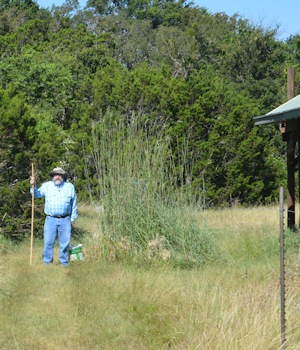 Why it’s called BIG bluestem: the pole is six feet tall
Why it’s called BIG bluestem: the pole is six feet tall
Four grasses form the foundation of the tallgrass prairie biome in the US: Big Bluestem, Switchgrass, Indiangrass, and Eastern Gama. Before this land was broken to the plow, fingers of tallgrass prairie existed here in the wetter lower spots, with midgrass (Little Bluestem, Sideoats Grama, Vine Mesquite, etc) prairie on dryer slopes and shortgrass on the rockiest areas. This is not quite the southernmost bit of tallgrass country, but it’s getting there. Read the rest of this entry »

Jun 13
Posted: under Climate Change.
Tags: carbon cycle, climate, prairie restoration, wildlife management June 13th, 2010
Carbon sequestration is the trapping of atmospheric carbon (carbon dioxide) into some form where it can stay for decades. Carbon sequestration occurs naturally by the actions of plants, especially long-lived vegetation, and in certain soils, where it’s deposited as slow-decaying organic matter. Plants use sunlight to convert atmospheric carbon dioxide into the chemical that make […] [...more]
Carbon sequestration is the trapping of atmospheric carbon (carbon dioxide) into some form where it can stay for decades. Carbon sequestration occurs naturally by the actions of plants, especially long-lived vegetation, and in certain soils, where it’s deposited as slow-decaying organic matter. Plants use sunlight to convert atmospheric carbon dioxide into the chemical that make up plant material–simple sugars, to start with, then starches and more complex chemicals when added to other nutrients.
Why is this of interest in wildlife management or prairie restoration? The obvious reason is climate change caused by increasing carbon dioxide levels. Carbon sequestration by changes in management of both public and private lands is one way to get carbon dioxide out of the atmosphere and into plant materials. Many of the things a land manager might do to promote wildlife or restore an original ecosystem (forest or grassland) will have multiple benefits…including carbon sequestration.
Read the rest of this entry »

Jun 06
Posted: under photography, Plantlife, Wildlife.
Tags: beauty, butterflies, insect, photography, prairie restoration June 6th, 2010
A few pictures from a week ago, May 30, and also from yesterday, June 5, as what’s blooming and in what abundance changes rapidly–especially in the hot, dry weather we’re having. (We did get 3/10 of an inch of rain. It barely wet the ground.) Variegated Fritillary, Euptoita claudia, on Gaillardia [...more]
A few pictures from a week ago, May 30, and also from yesterday, June 5, as what’s blooming and in what abundance changes rapidly–especially in the hot, dry weather we’re having. (We did get 3/10 of an inch of rain. It barely wet the ground.)
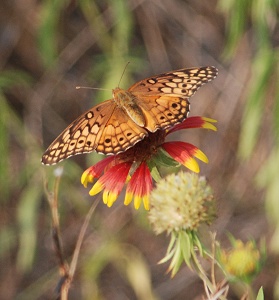 Variegated Fritillary, Euptoita claudia, on Gaillardia
Variegated Fritillary, Euptoita claudia, on Gaillardia
Read the rest of this entry »

May 29
Posted: under photography, Plantlife.
Tags: beauty, native plants, photography, prairie restoration May 29th, 2010
Near Meadow: Claspleaf Coneflower and Lemon Horsemint [...more]
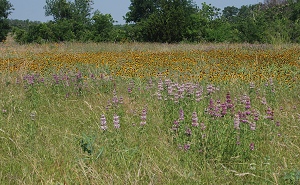 Near Meadow: Claspleaf Coneflower and Lemon Horsemint
Near Meadow: Claspleaf Coneflower and Lemon Horsemint
Read the rest of this entry »

May 28
Posted: under photography, Plantlife, Wildlife.
Tags: beauty, beetle, butterflies, photography, prairie restoration May 28th, 2010
The basketflower, Centaurea americana, looks much like a thistle at first…but the stem and leaves are not prickly at all. It’s a favorite of Black Swallowtail butterflies (and Giant Swallowtails, if there’s enough moisture for the flowers to last into summer) and many smaller butterflies. And also other insects. Beetle flying toward Basketflower already occupied […] [...more]
The basketflower, Centaurea americana, looks much like a thistle at first…but the stem and leaves are not prickly at all. It’s a favorite of Black Swallowtail butterflies (and Giant Swallowtails, if there’s enough moisture for the flowers to last into summer) and many smaller butterflies. And also other insects.
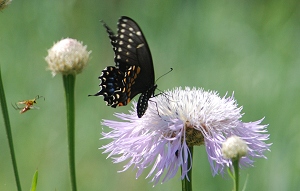 Beetle flying toward Basketflower already occupied by Black Swallowtail
Beetle flying toward Basketflower already occupied by Black Swallowtail
Read the rest of this entry »

Nov 10
Posted: under photography, Plantlife, Water.
Tags: butterflies, native plants, odonates, photography, prairie restoration, water resource management November 10th, 2009
We have no permanent natural water on the place. But when it does rain, we have a variety of temporary water sources, from the actual creek to the various overflow channels (some of concern because of erosion; others now pretty much “tamed.”) [...more]
We have no permanent natural water on the place. But when it does rain, we have a variety of temporary water sources, from the actual creek to the various overflow channels (some of concern because of erosion; others now pretty much “tamed.”)
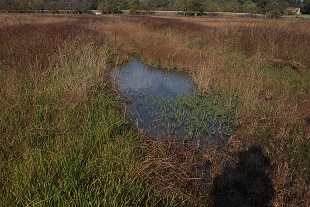
Read the rest of this entry »

Nov 06
Posted: under Activities, photography, Plantlife, Wildlife.
Tags: Activities, beauty, butterflies, census, native plants, photography, prairie restoration November 6th, 2009
Some grasses should be planted just for the way they look with sunlight slanting through them in the fall. This is one. It’s one of the Muhlys, but I don’t know which. [...more]
Some grasses should be planted just for the way they look with sunlight slanting through them in the fall.
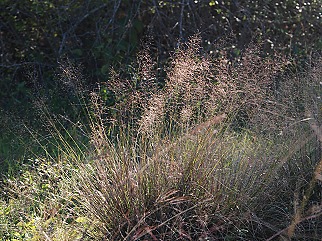
This is one. It’s one of the Muhlys, but I don’t know which.
Read the rest of this entry »

Oct 20
Posted: under photography, Plantlife, Water.
Tags: beauty, grass, native plants, photography, prairie restoration, rain October 20th, 2009
An introduction to some more of our “big” grasses, now flowering beautifully after the rain. Two are climax tallgrasses, and one is (in my opinion) one of the most beautiful grasses in the country and deserves to be used more as a landscape accent. Meet Lindheimer Muhly (Muhlenbergia Lindheimeri). All the Muhlys are pretty grasses; […] [...more]
An introduction to some more of our “big” grasses, now flowering beautifully after the rain. Two are climax tallgrasses, and one is (in my opinion) one of the most beautiful grasses in the country and deserves to be used more as a landscape accent.
Meet Lindheimer Muhly (Muhlenbergia Lindheimeri). All the Muhlys are pretty grasses; some are more striking than others, but Lindheimer Muhly is the queen of the lot:
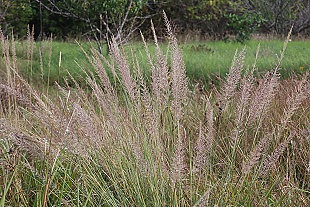
Read the rest of this entry »

Sep 25
Posted: under photography, Plantlife, Water.
Tags: beauty, native plants, photography, prairie restoration September 25th, 2009
Altogether, we’ve had 10 inches of rain since the big rain started. Though it’s too late for some things, others have recovered well. The yellow flowers are two-leaf senna, and the pink is the rose-oxalis that usually blooms in the early spring. [...more]
Altogether, we’ve had 10 inches of rain since the big rain started. Though it’s too late for some things, others have recovered well.
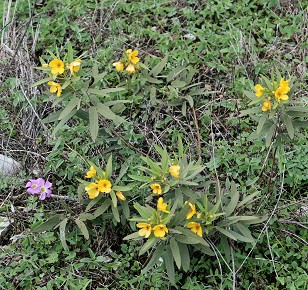
The yellow flowers are two-leaf senna, and the pink is the rose-oxalis that usually blooms in the early spring.
Read the rest of this entry »

Aug 13
Posted: under Climate Change.
Tags: climate, drought, prairie restoration August 13th, 2009
Since habitat management is part of wildlife management, restoration of degraded or poor habitat is part of our job as wildlife managers. The basic concepts were laid down years ago…but the devil’s in the details, as usual. The July 31, 2009 Science had an entire section on restoration ecology, with examples drawn from around the […] [...more]
Since habitat management is part of wildlife management, restoration of degraded or poor habitat is part of our job as wildlife managers. The basic concepts were laid down years ago…but the devil’s in the details, as usual. The July 31, 2009 Science had an entire section on restoration ecology, with examples drawn from around the world showing the benefits, costs, and difficulties in this field. Especially with the advent of global warming.
Read the rest of this entry »

 Why it’s called BIG bluestem: the pole is six feet tall
Why it’s called BIG bluestem: the pole is six feet tall






